Or rather, how I made my life infinitely easier, thanks to the amazing David Didau (@learningspy) and his approach to progress in the English classroom.
When I took over as Key Stage 3 co-ordinator at HPS, I was aware that something needed to change. Marking was a major factor in the lives of the English department and as a result, staff weren’t able to offer the level of challenge or the range of subjects they really wanted to. We all felt under immense pressure to produce books with reams of dialogue written in glorious green pen, showing clear targets for improvement but also recognising good work and effort. Examples were shown to us of books where the teacher had written at least a paragraph at the end of each paper; the work had been meticulously read and picked apart and the feedback, though faultless, was lengthy and tiresome. Morale was dipping, staff were tired, and something needed to be done.
What we were all already aware of was that all of the above means nothing, nothing at all, to a 12 year-old boy who really just wants to know what level he got. Though the feedback was lengthy, there was no proof that anything was actually read, or acted on, at all. What I wanted to see was evidence of students making an effort to improve. So how do we make a change?
In February 2014 I was lucky enough to attend the Brighton and Hove Joint Practice Development Day (JPDD), where teachers from across the county get together to collaboratively deliver and receive excellent CPD, sharing best practice from across the LEA. It’s a great day and a wonderful opportunity to develop your practice. It was here that I first met David Didau. I won’t go into the specifics of his presentation now – that’s another blog post entirely – but the day encouraged me to engage in some reading, and I looked up Didau’s blog with fervour. His enthusiasm and charisma had encouraged me and I was keen to learn more. Little did I know that what I was going to read would change my practice and save my sanity…
DIRT and Triple Impact Marking
One method of marking that Didau advocates is that of Triple Impact Marking. He doesn’t claim to be its inventor, that was Clevedon School, but he is a fan; the basic process is this:
– The student completes the work;
– The teacher feeds back on the work;
– The student improves the work.
It seems simple, but I’ve been quite shocked by how little of it I have seen when browsing books across different schools.
Now, in recent times there has been some debate about this, specifically regarding Ofsted’s assertions that they categorically do not expect to see reams of dialogue in students’ books (Didau himself wrote a blog about why he may have been wrong after all), but I tend to believe that TIM, when used sensibly, is actually extremely beneficial.
In my classroom, I pair TIM with DIRT – Directed Improvement and Reflection Time, a term again introduced to myself by Mr Didau. For those not au fait with the term, DIRT is written into lessons to allow students to spend time re-drafting, evaluating and understanding their work, errors and all. Of course, we put our own HPS twist on this, and came up with our own version of TIM, using the principles of DIRT and our own shortcuts to ensure that marking load was significantly reduced.
After a few tweaks, we found a way that proved easy to navigate – all staff were on board, students were engaging and progress was beginning to shoot up, despite the challenging new curriculum and the introduction of unseen assessments. In addition to this, staff morale was raised, teachers were able to mark a set of books in the space of one free (really!) and less work was being taken home, saving my team’s relationships, sanity and lower backs.
So, how did we do it?
English: Marking at HPS
Most importantly, and before beginning: Do not accept sub-standard work. If it’s poorly presented, send them back and make them do it to their best. Only then is it OK to be marked (thanks, David!).
This means that at times, you may end up repeating an entire lesson as the class simply did not meet the standard expected of them – this isn’t a crime! Redrafting helps even the most able student to reflect, and the more students understand that they can’t get away with the bare minimum, the less you’ll see the bare minimum in their books. Repetition is your friend, people.
– Teachers can regularly mark using highlighters. This can be done in the classroom as the lesson takes place, and you can usually get through at least 4 books in a lesson. Pink highlighters pick out work that is exceptional or interesting; yellow highlighters show that something needs to be fixed. The beauty of this is that it automatically increases independence as students need to actively look for what needs fixing; at the same time, it saves you an awful lot of work. Encourage students to make changes there and then.
– Teachers mark in red. Feedback is minimal and takes the form of a question or small task, i.e. what is the effect of this word choice? How do you think Shelley wanted us to feel? Can you think of better alternatives to the words in yellow? Questions posed focus on getting more out of the student and building positive habits. One of my personal favourites is simply Why?
– Whenever a teacher has marked a task, the following lesson incorporates ten minutes of DIRT at the start. Students are handed a green pen and spend this time improving their work, using the targets you have set. Then you can check this and mark using either the highlighters or the red pen; it’s really up to you.
– Peer- and self-assessment are all done in green pen; this way, you can see the dialogue between student and teacher and easily see where the student has done more work than the teacher (as they should!)
– The English department puts aside an hour a week to mark collaboratively. This way, staff are able to air concerns, share best practice, understand progress better and generally enjoy the process of marking. We timetable it so that it can’t be taken away – no emergency meetings with parents or SLT at the last-minute, thank you very much!
– Finally, work is rarely levelled until the very end (though students may self-assess at any point. I always refuse to substantiate their claims, though, until it’s done completely). This way, they cannot sit back and accept the C grade as ‘enough’.

If used consistently, this method can truly change your life. At first, it can be scary to let go and trust the students to reflect on their work; you may even get the hardcore crew who simply refuse to co-operate, but trust me, as time goes by they will see the others progressing and begin to understand that they need to be doing the same.
One of the biggest perks is that it becomes extremely easy to see where students are excelling and where they are struggling. By marking quickly and regularly, I get to know them better – for example, I had a good 75% of the class failing to explore layers of meaning in a pre-essay task, so I was able to address this in the next lesson and ensure that no student sat the essay without understanding the importance of this skill. It means that I can keep a close eye on my vulnerable students – I can mark these first and keep a close eye on them in the classroom. My marking informs my planning, not the other way around. I’ve found that this has helped me to build stronger relationships with my students than ever before and I’ve really enjoyed watching them grow.
So, thank you David – for revolutionising the way we mark at HPS!

